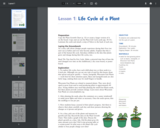
To observe and understand the full life cycle of a plant.
- Subject:
- Agriculture, Food and Natural Resources
- Career and Technical Education
- Material Type:
- Activity/Lab
- Author:
- National Gardening Association
- Date Added:
- 03/18/2024

To observe and understand the full life cycle of a plant.

By the end of the lesson, students will:
1-Understand how environmental pressures influenced the evolution of wings and how natural selection resulted in the diversity of bird species that exist today.
2-Understand the mechanics of flight and the anatomical features that provide lift and maneuverability in the air.

Join Danny Rubin, founder of Rubin, and as he talks with Alex Martson and Ryan Fleischer about working in the world of agriculture for a family farm and home delivery meat and seafood service, respectively. Students and teachers should also make use of the webinar worksheet at https://rubineducation.com/wp-content/uploads/2021/05/Rubin-Webinar-Worksheet-Q-and-A-about-Agriculture.docx

This lesson is great to use in Intro to Ag or Animal Science. It will have students work through basic information about livestock animals and the livestock production methods.

Students in Grades 3 & 4 at Chain Exploration Center developed an understanding of the important role that pollinators play in human food systems as well as in native habitats. Students also learned about the stressors, many of them human-influenced, that are associated with the decline in pollinator populations. Students also learned about ways that humans can improve pollinator habitat. The culmination of student learning was an environmental stewardship project: the installation of a pollinator garden on the school grounds. What follows is an outline of the project process and a discussion of the resources that were used.

Wisconsin DNR link to look up most private or public wells. Can use Map View or by unique Well ID number. Well construction information, including geology, construction method, well depth, water depth, well yield and other information about the well.
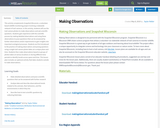
This activity complements Snapshot Wisconsin, a volunteer-based wildlife monitoring project involving a statewide network of trail cameras. In this activity, students will use the trail camera photos to make observations and ask scientific questions. Students gain experience with the scientific process by making detailed observations and using these observations to pose questions that can be answered by further observations and/or experiments to gain insights into important ecological processes.
Students are first introduced to the practice of making observations and posing questions using a single trail camera photo taken at a unique place and time. Students then make observations based on groups of photos taken at various locations or during different time periods to identify trends across space and time. This lesson plan includes an optional activity that takes students outside to make observations.

Students learn about the enzymes and chemicals that are used in the digestion process of the body. They run a lab to show the normal digestion process and then choose a variable to change that will test one aspect of disgestion and run the lab again and incoporate that variable.
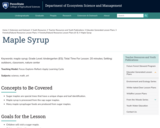
Goals for the Lesson
Children will visit a sugar maple.
Children will identify a sugar maple.
Children will discover how maple syrup is processed.
Children will taste maple syrup/sugar products and graph the results.

Maple Grove Charter School, Athens School District, is a Grades K-5 elementary school located the heart of the rural Town of Hamburg. The school takes its name from the school forest on its site. Built in 1904, the school has annual tradition of tapping the maple trees. What started as a first grade classroom project has expanded as students from each grade level identify, tap, and collect sap from two trees. Unit plans have been created for each grade level to address agriculture, science, literacy, social studies, math, and environmental literacy standards. While the sap collecing routines remain relevatively constant each year, the learning opportunties have been differentiated by grade level so that students are always learning new content and skills.In the following unit plan discussion readers will learn about the schoolwide project from the perspective of teachers in Grades 1 and 5.Students in Grade 1 learn about maple tree identification and the traditional and modern tools and technologies employed in sap collection and syrup production. Their fifth grade counterparts continue to grow in their understanding of the tapping, collection, and production processes, and take on the role of entrepreneurs as they develop their brand and market the finished pure maple syrup.

Students in Grades 1 & 2 at Chain Exploration Center developed an understanding of the maple syrup production and its importance as an agribusiness. Students also learned about plant structures and their role in photosynthesis and the ecosystem services of sugar maple trees. The culmination of student learning was a project showcase in the form of a Maple Tree Museum to which parents and community members were invited. What follows is an outline of key place-based lessons and experiences that supported students’ learning.

The mathematical modeling process often begins with messy real-life problems that require students to formulate questions, make assumptions, and construct a mathematical model to describe a real world situation. Wisconsin Math Council is happy to launch our Wisconsin Modeling Challenges. Each challenge contains the context and a strategy to launch the modeling task so that students at any grade level can identify questions and make observations. Each challenge also contains specific grade level modeling tasks related to the context. WMC hopes that these challenges will engage your learners in experiences to become “flexible users of mathematics who see how mathematics can be used to understand their world and the world around them.”
The Context for Challenge 1: Meals on Wheels delivers approximately 221 million meals each year to 2.4 million seniors. Meals are delivered around lunch time by volunteers who also conduct wellness checks.
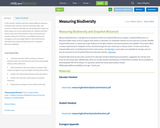
In this activity, students will learn about different measures of biodiversity: richness, Shannon diversity index, and evenness. Students will begin by calculating these indices by hand using a very small sample data set. Students will then read an overview of the Northern Lakes and Forests and Southern Wisconsin Till Plains, two different Wisconsin ecoregions, and use Google Sheets or Microsoft Excel to calculate and compare biodiversity from a Snapshot Wisconsin database

This mechanical model of the phalarope beak, showing the transport of a micro-liter droplet, helped researchers from MIT and colleagues from Ecole Polytechnique in Paris discover how the phalarope propels food upwards to its throat. The video was captured at 2000 frames per second but has been slowed down to 30 fps for this clip. Researchers had known that the phalarope draws food-rich water into its mouth in a gravity-defying manner, but until now, no one knew how. Using a mechanical model of the phalarope beak, the MIT and Ecole Polytechnique researchers recently discovered how the birds use surface interactions between their beaks and the water droplets to propel bits of food from beak tip to mouth.
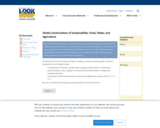
This kit explores how sustainability has been presented in the media with a particular focus on issues related to food, water and agriculture. Each of the 19 lessons integrates media literacy and critical thinking into lessons about different aspect of sustainability. Constant themes throughout the kit include social justice, climate change, energy, economics and unintended consequences.

Power point, note sheet and worksheet to use as an introduction to Punnett Suqares and Mendelian Genetics.

The students will develop an understanding of how ethnographers studied the Native American uses of plants in the Wisconsin region. They will learn specically about Menominee, Ojibwe, Potawatomi, and Meskwaki tribal uses of plants.

Students will identify a specific plant used for dye. They will learn the proper method and prayers in the Menominee language for collecting plants for use in creating the dyes.

Students will learn about the process of Batik while using the natural dyes used by their ancestors to create a work of art that will also function as a teaching tool for other and future students.

This unit consists of the Origin of the Menominee from various sources as well as lessons attached that discuss the Menominee Clan system including links to research sub-clans, mini-language lessons, the exploration of the 12 Tribes of Wisconsin and a highlight of the Menominee Forestry Practices including a Lesson on the Menominee Tribal Enterprises.